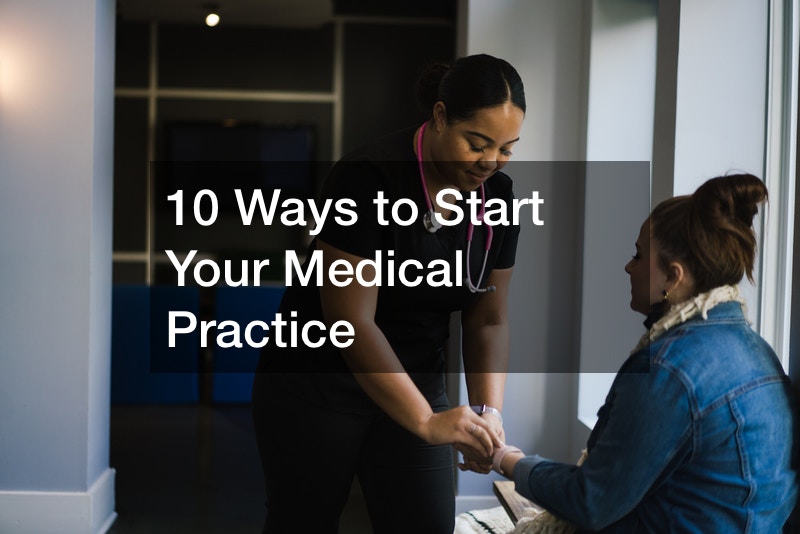

Starting a medical practice can be a daunting task. Medical schools don’t teach the business side of the medical sector. Though you’ve adequate practice experience, you need to learn the steps of starting successful clinics.
Use potential client needs to guide your process. The wants determine your location, insurance, and credentials. The preparation process is time-consuming, but the rewards are worth the hassle.
Medical business plans guide lenders on the type of loan and amount. You should make sure the business plan captures accurate information and your financial situation. A strong plan will give you the upper hand in getting enough financing.
Professionals like healthcare attorneys, financial advisors, and building experts help in the process. Make use of professional experts to avoid losses and non-compliance problems.
This article consists of a guide to starting a successful medical practice.
1. Determining Type of Medical Practice
The first step to starting medical business plans involves selecting your preferred practice type. There are six types of medical practice. Here are their tenets.
Solo Practice
In this medical practice, you run almost all duties and responsibilities. You’ll follow state and professional licensing laws, but you’re not subjected to other external influences. You’re in complete control of all the operations.
On the flip side, you’ll need to put on more hours and bear the total starting costs and risks.
Group Practice
The practice will include two or more doctors from the same or different specialties providing medical care at the same center.
The starting and risk burden is shared evenly among the group members. You’ll get fewer working hours at the expense of shared autonomy. Access to working capital is easy, and start-up costs are lower.
Hospital Owned
You provide treatment services for people in a hospital network. You’re a hospital employee; thus, you don’t have the added responsibilities of running your office. You’re subject to employee constraints.
The hospital provides working capital and has marketing resources. The practice is less flexible, but you’ll minimize the costs.
Locum Tenens
Doctors serve temporarily as fill-in physicians. The assignment may range from several months to several days. As a medical practitioner, you have the freedom to organize your schedule and geographical working area. Also, you can keep off interoffice politics.
The disadvantage is that you don’t have job security.
Federally Qualified Health Centre
You need to follow federal policies on working capital to start this type of medical practice. They’re outpatient clinics and qualify for reimbursement systems.
Academic Health Centre
Compared to federal health centers, you’ll experience fewer caps. The practice minimizes risks and sacrifices autonomy.
2. Preparing a Business Plan
Medical business plans are like roadmaps to starting a medical practice; one of the most critical tools of budding or existing entrepreneurs. In writing a plan, follow the steps below.
State Goals Clearly
Outline the explicit goals of your business. You’ll set parameters for building successful medical practice to achieve your vision. Essential considerations include;
- Estimated number of patients to visit per week
- Estimated weekly income
- Number of support staff and physicians you’ll need
Conduct research to help draw succinct conclusions.

Have Financial Knowledge Background
As a budding entrepreneur, address the following issues.
- Cost of getting your medical practice up and running
- Expenses compared to potential income
- Profitability of the practice
Calculate all expenses, including technology, furniture, equipment, to figure out future income. Also, calculate ongoing expenses like salaries, licensing costs, software management, medical insurance, and rent.
Including Executive Summary
Have a brief overview of all essential points of medical practice and the benefits of your business. Give an apparent reason why your business is vital to patients. What problem does it solve? If possible, add it to your company’s mission along with its objectives.
Outline Your Market Research Findings
Write about patients’ demographics and the services you plan to offer. What is your ideal client? Include the means you’re going to use to reach your target clients.
Opportunity
State the existing opportunity for your medical business plans. List the services you are planning to offer. Show a gap you want to fill by providing the outlined medical services.
Budget and Projections
Add your future revenues and expenses. Ensure they’re detailed. It’s advisable to estimate three years’ expenses when starting a capital loan. But you can predict for at least twelve months.
With earning potential, create a budget. Take into account unexpected expenses.
3. Getting Financing
With medical business plans in place, you can go ahead to look for a financial institution to fund your medical practice. Below are some financing tips.
Finding Specialists
Submit your business plan to the dental/ medical divisions of financial institutions, if any. The specialists have a vast knowledge of the medical sector and understand risks, revenue, and expense models.
Comparing Banks
When submitting a business plan, do it in five to ten banks. This way, you’ll receive several offers on different terms. Make a decision based on the most critical terms, like interest rates, repayment period, and approved loan amount.
Staying Conservative
Stick to your medical business plans when buying equipment and software to be used in your medical practice. If you choose to go with two doctors office to start, stick to the plan. You’ll be able to control additional expenses and ensure you don’t run out of budget.
Waiting Time
Banks take some time to approve and disburse loans. Tackle other vital steps like incorporating a legal entity, signing a lease, and getting a tax ID.
4. Choosing Location
The location of your business is as vital as the steps of starting it. Getting an appropriate location ensures that clients can reach you hassle-free. The renting and leasing processes can take some time. Here are some of the factors to consider in selecting a practice location.
Community Demographics
Ensure you’re happy staying in the area. You’ll spend most of your time there. The population should be large enough to support your practice; a large population pools a higher number of patients.
Also, look at the population’s average age, income level, and local employers. A few young people can’t support your practice. Residents should afford your services. Large local employers will increase insurance coverage.
Regional Competition
Look at your local competitors. Know how many other physicians provide the same medical services and their proximity to your preferred location. If your competitors are more established, you’ll need to outsmart them in marketing to have market share.
If you’re starting, find an unexploited/underserved region to practice in. This way, attracting customers will be easier.
Visibility of Your Potential Location
It will help if you put some effort into improving your visibility. Signage boards and floral shops will market you on highways to people driving or walking.
If you have secluded locations, look for alternative marketing strategies like hiring a content marketing company to write content about your business and location.

Building Aesthetics
Location appearance serves as the first customer experience. If the house is older, make sure it’s well-maintained. The associated business waste solutions should be reliable and efficient since medical practice must be clean throughout.
Before beginning your operations, needed flooring repair should be done. Consult companies in your area can provide tile roofing services. Additionally, get a design build electrical contractor to renovate the electrical systems to make them stunning and inviting.
5. Choosing a Legal Structure
The structure should set you on a successful path and address your medical practice needs. The structure options include:
- Limited liability partnerships(LLPs)
- Professional limited liability companies(PLLCs)
- Professional associations(PAs)
Each practice is unique in terms of tax obligations and liability. The type you select should align with your medical practice details, expected liability amount, and tax obligations. Consult with a healthcare attorney to select an excellent legal structure.
6. Applying for a Medical Practice License
The process of applying for medical practice licenses can be time-consuming. But if you follow the correct procedures, you’ll save considerable time.
States require doctors to meet eligibility criteria to get a medical license. The process is as follows.
- Filling in application forms called Uniform Application for Licensure online.
- Completing your Federal State Medical Board (FSMB) profile
- Submitting and storing core medical documents
- Applying licensure affidavit
Note that the medical license requires renewal after some time, depending on the state of operation. Typically, the period ranges from one year to four years, depending on your state.
7. Getting Medical Credentials
There are requirements you’ll need to satisfy to practice legally and submit claims. First, apply for a National Provider Identifier number and get the required state medical licenses.
Once licensed, commit to the credentialing process by verifying your educational qualifications and licensure. When through, you can accept insurance from Medicare and Medicaid programs and private medical insurance providers. Choose insurance companies to work with and talk with them on terms.
Set up systems to ensure all staff has the training required for your practice to be compliant. Here is the compliance training needed.
- Stark compliance
- OSHA compliance
- HIPAA compliance
- CLIA compliance
8. Getting Insurance
You can’t underscore the benefits of insuring medical practice. Understand the mandatory and optional insurance. You can consult with private wealth management service companies or other business advisors in your region on preferable insurance combinations.
Common insurance types include;
- Malpractice
- Liability
- Life, Health and Disability
- Workers Compensation
- Disability Coverage
- Umbrella Policy
- Business Interruption
9. Buying Equipment and Software
Put together essential software and equipment to facilitate the operations of your medical practice. Stick to your medical business plans, and get only essential supplies first.
The software includes;

Electronic Health Record(EHR)
The system will allow the digitization of medical records and help in streamlining communication. EHR acts like a one-stop shop containing patient records, healthcare workers’ communications, prescription and lab orders, and revenue cycle information.
EHR facilitates federal incentive payments.
Practice Management System
It is integrated with EHR; it’s vital in keeping front office information and facilitating operations. Also, it conducts and manages utility billing and medical practice revenue cycles. Also, it avoids cases of duplication by sharing relevant information with EHR.
Medical Billing Service
Outsourcing billing services will relieve your staff of the tedious process of claiming and billing. The staff will have adequate time to attend to other essential tasks. However, you’ll still need the software.
Medical Transcription
The transcription software works in three dimensions.
- In-house led by a team member
- Outsourced
- Voice recognition
The key aspects to look out for when shopping for software include accuracy and timelines. Dictations need not only be printed quickly, but they should also be accurate.

Medical Supplies
Remember that medical supplies should be bought when medical practice approaches opening doors to customers. Keep in mind your medical business plans when buying the equipment. The supplies include;
- Examination tables, stethoscopes, otoscopes, and blood pressure equipment.
- Fax machines, phones, computers, and credit card processor hardware.
- Utilities and internet
- Lab coats, name tags, staff uniforms, and patient gown clothes.
- Furniture like chairs, desks, and Cambria countertops
- Alternative energy source from a nearby commercial solar power company
10. Marketing
Like any other business, marketing will cement your presence in a new region. Potential clients need to know your medical practice existence, the services you offer, and the clinic location. Marketing doesn’t stop and should be included in medical business plans to succeed.
Tips for building a proper marketing strategy include;
- Building a website
- Claiming local listings
- Sending newsletters to clients
- Starting patient referral programs
- Starting a blog
- Getting published in journals
Marketing is different from advertising. Advertising is a part of an effective marketing plan.
Conclusion
Opening your medical practice and serving patients is the ultimate goal. To get to it, you need to follow the outlined steps keenly. Sticking to your budget all through will help in meeting all the costs.
Financial institutions will advance starting capital based on your stated case in medical business plans. Selecting the location, legal structure, and insurance policy ensures needs are met.
Apply for licensing and credentials before opening your medical practice to avoid issues of compliance.





